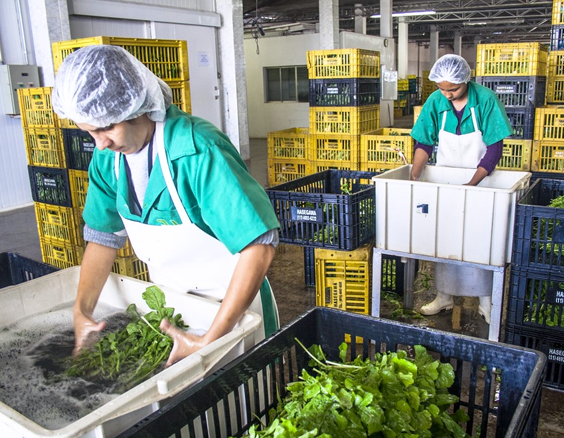This article is part of World War “V”: The COVID-19 Pandemic, a collection of all CNS COVID-19-related articles.
June 12, 2020
Bennie Osburn and Richard Pilch
On May 22, 2020, China announced an ambitious food security plan to meet immediate and long-term nutritional needs of its citizens. [1] While we in the United States typically assume that we will always have a plentiful food supply, the events of COVID-19 have exposed key fracture points in the American food system that must be addressed to ensure our food security for the duration of the pandemic and beyond.
The first key fracture point is the impact of food worker infection; the second is the impact of cratering demand due to the loss of food-service clients (such as closed restaurants and schools), as well as the growing concern of lost wages among retail consumers.
Food Worker Infection
Food travels from farm to consumer on a “farm-to-fork” continuum wrought with potential bottlenecks. The most costly bottleneck occurs early along the continuum, at a limited number of processing plants where plant workers labor in close quarters to prepare farmed products for retail consumption—work conditions ripe for COVID-19 transmission. A COVID-19 cluster at any one processing plant can have devastating consequences, ranging from reduced capacity under the Defense Production Act—which President Trump invoked on April 28 to classify meat plants as essential infrastructure that must remain open [2]—to prolonged closure for disinfection exemplified by Tyson Foods and Smithfield, where infections forced plant shutdowns responsible for a 25 percent reduction in beef and pork production nationwide. The number of COVID-19 cases at processing plants has more than doubled since President Trump’s executive order, and corresponding workplace protective measures have been fragmented. [3]

Elsewhere on the farm-to-fork continuum, farms across the US have begun to realize the harvest impact of COVID-19 illness among field workers, [4] a number of whom are undocumented and subject to overcrowded group housing with no opportunity (or option) for self-isolation. [5] In Singapore, similarly poor migrant worker living conditions led to an April case resurgence after the country appeared to have the pandemic under control, demonstrating the importance of robust medical surveillance, testing, and physical distancing in such settings. [6]
Cratering Demand
The $300B food-service industry has declined an estimated 60–90 percent since the pandemic began, driven primarily by restaurant and school closures that account for the bulk of food-service sales. [7] Product cannot be readily shifted to retail sales—despite the draw of continued panic buying—due to supply-chain limitations such as packaging size and labeling. Should unemployment rise, lost wages could drive down retail demand as well, as consumers increasingly turn to strained food assistance programs or seek less costly alternatives.
Path Forward
What must farmers, food-processing companies, truckers, wholesalers, retailers and government do to adapt to these effects?
The first step is to understand the occupational risk that COVID-19 poses on food workers. Like healthcare workers, food workers may be compelled to labor, often in close quarters, in the face of infection. It is therefore imperative to ensure that appropriate safety measures are implemented to protect them. As in a hospital, such measures include training on infection control; adequate personal protective equipment such as gloves and masks; and administrative controls including workplace spacing at least 6 feet apart, start-of-shift temperature screens at the facility entrance, mandatory stay-at-home guidance for workers with elevated temperatures or other COVID-19-like symptoms, paid sick leave, and adequate physical distancing in group housing. [8] Essential workers must take greater care to avoid contact with others both on and off the job, but employers bear the brunt of this responsibility. It has become mission critical for all commercial food operators to adapt their businesses to protect workers and remain vigilant to stop the spread of the virus.
The second step is to understand that pandemics usually involve multiple waves. As social restrictions begin to ease in hard-hit areas of the United States, a resurgence of COVID-19 and continued impact on the American food system should be expected. We need to learn from the first months of the pandemic to prepare for the months to come. Early on, farmers and food processors supplying products in bulk could not adapt quickly enough when restaurants were abruptly shuttered. Most dairies lost their school lunch or food-service accounts and were forced to dump milk. Ensuring future resilience will require the flexibility and innovation to design product offerings that meet both the realities of the world and the changing needs of consumers.
We need to learn from the first months of the pandemic to prepare for the months to come.
–Richard Pilch
The remarkable American food system is a complex, well-synchronized machine built on “just in time” delivery to produce healthy, dependable, safe, and affordable food. Looking ahead, it must transform to become more agile and scalable, with enough redundancy to reliably source, process, transport, and deliver products regardless of the size of the next pandemic wave. These are not minor changes that can be easily made by an industry financially decimated by COVID-19. These changes require collaborative government and industry leadership and support for our food supply to ensure consumers maintain confidence in our food system. As proven by recent events, our food supply system must become a national priority.
It’s time we put our money where our mouth is.
Dr. Bennie Osburn is Dean Emeritus of the University of California (UC) -Davis School of Veterinary Medicine and Director of Outreach and Training at UC-Davis’s Western Institute for Food Safety and Security (WIFSS). Dr. Richard Pilch is the Director of the Chemical and Biological Weapons Nonproliferation Program at the James Martin Center for Nonproliferation Studies (CNS), Middlebury Institute of International Studies at Monterey (MIIS).
